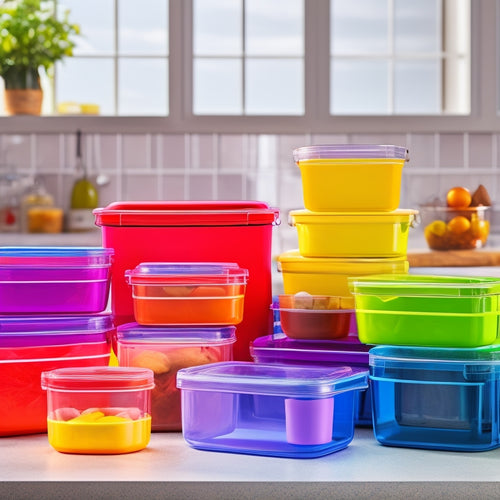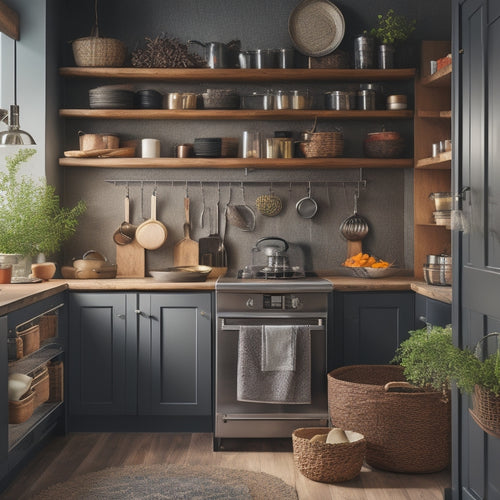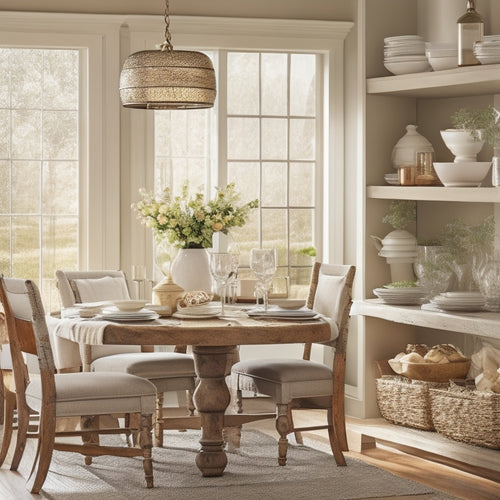
Effortless Kitchen Remodel: 10 Workflow Hacks
Share
To accomplish an effortless kitchen remodel, begin by simplifying your design process through gathering inspiration and narrowing it down to 3-5 distinct styles. Then, coordinate material deliveries and prioritize them based on project progression. Develop a realistic timeline by breaking down tasks into manageable chunks and considering contingencies. Give priority to tasks by urgency and concentrate on critical tasks initially. Appoint a project manager to supervise the project schedule and communicate regularly with stakeholders. By implementing these workflow hacks, you'll be well on your way to a stress-free remodel, and the best part is, there are even more strategies waiting to be uncovered to guarantee your dream kitchen becomes a reality.
Key Takeaways
• Simplify the design process by gathering inspiration, creating a visual library, and narrowing down preferences to 3-5 distinct styles.
• Coordinate material deliveries, prioritize them based on project progression, and plan for supply chain considerations to avoid delays.
• Break down the project into manageable chunks, factor in contingencies, and establish clear communication channels to stay on schedule.
• Prioritize tasks by urgency, focus on critical tasks first, and use a color-coded system for task categorization to reduce stress.
• Assign a single person to supervise the remodel, develop a communication strategy, and delegate tasks to the right people to ensure a smooth project flow.
Simplify Your Design Process
Start by gathering inspiration from various sources like Houzz, Pinterest, or kitchen design blogs to create a visual library of your dream kitchen, and then narrow down your preferences to 3-5 distinct styles that resonate with your taste and lifestyle. This will help you identify your design inspiration and create a cohesive look.
As you browse, take note of the color schemes that catch your eye. Are you drawn to bold and bright, or soft and subtle? Create a board or album to collect your favorite images, and start to see patterns emerge.
Next, it's time to think about budget planning. Determine how much you're willing to spend on your kitchen remodel, and allocate funds accordingly. Consider not only the cost of materials but also labor costs, which can quickly add up. Be realistic about what you can afford, and prioritize your must-haves.
Streamline Material Delivery
With your design and budget plans in hand, coordinate with your suppliers to schedule material deliveries, making certain that all necessary items arrive on site in a logical and efficient sequence. This delivery coordination is essential to maintaining a smooth project timeline.
You'll want to prioritize deliveries based on the project's progression, so that materials are on hand when needed, but not so early that they're in the way or at risk of damage. Consider the supply chain and plan accordingly. For instance, if you're waiting on a custom cabinet order, schedule the delivery to coincide with the installation of flooring and walls.
Meanwhile, make arrangements for material storage on site, designating a specific area for receiving and organizing deliveries. This will help prevent clutter and confusion, keeping your workspace organized and efficient.
Create a Realistic Timeline
Your kitchen remodel's success hinges on a well-planned schedule that accounts for every task, from demolition to final inspection, and allocates realistic timeframes for each step. A well-crafted schedule helps in setting expectations and managing anticipations, guaranteeing that you and your stakeholders are on the same page.
To create a realistic schedule, follow these essential steps:
-
Identify project milestones, such as completion of plumbing, electrical, and flooring installation
-
Break down each task into smaller, manageable chunks, and allocate specific timeframes for each
-
Factor in contingencies, such as unexpected delays or changes in design
-
Establish clear communication channels with your contractor and suppliers to make certain everyone is tracking progress
-
Regularly review and update your schedule to reflect changes and adjustments as needed
Prioritize Tasks by Urgency
As you've established your realistic timeline, it's time to focus on tackling the most critical tasks first, making sure you're addressing the most pressing needs of your kitchen remodel.
To do this, you need to prioritize tasks by urgency. Start by making a list of all the tasks involved in your kitchen remodel, from demolition to installation. Next, assess the urgency of each task by asking yourself, 'What needs to be done first to guarantee the project stays on track?'
Create a color-coded system to categorize tasks based on their level of urgency. For example, use red for high-priority tasks, yellow for moderate-priority tasks, and green for low-priority tasks. This visual system will help you quickly identify which tasks need attention first.
By prioritizing tasks by urgency, you'll be able to manage your time more effectively, making sure you're completing the most critical tasks first. This will help you stay on track, reduce stress, and ultimately achieve an effortless kitchen remodel.
With task organization and time management in place, you'll be able to tackle your kitchen remodel with confidence.
Designate a Project Manager
Assign one person to supervise the entire kitchen remodel, making sure all tasks are completed efficiently and effectively, and that every decision aligns with your vision. This project manager will be responsible for developing a communication strategy, delegating tasks to the right people, and confirming that everyone is on the same page.
Some key responsibilities of your project manager include:
-
Coordinating with contractors and suppliers to guarantee timely deliveries and installations
-
Managing the budget and making adjustments as necessary
-
Overseeing the project schedule and identifying potential roadblocks
-
Making decisions that align with your vision and design goals
-
Communicating with you regularly to make sure you're informed and satisfied with the progress
Minimize On-Site Decision Making
By nailing down every design detail and material selection beforehand, you'll avoid costly delays and changes that can derail your kitchen remodel. This is essential because on-site decision making can lead to decision fatigue, which can result in poor choices that affect the overall project.
To minimize on-site decision making, create a detailed plan that outlines every aspect of your kitchen remodel. This includes:
| Design Element | Selection |
|---|---|
| Cabinets | White shaker-style with soft-close drawers |
| Countertops | Quartz with a waterfall edge |
| Flooring | Hardwood with a dark stain |
| Lighting | Pendant lights above the island |
| Backsplash | Subway tiles with a herringbone pattern |
Leverage Technology for Efficiency
You can streamline your kitchen remodel by harnessing the power of digital tools, which can help you visualize and manage the project more effectively. By leveraging technology, you can save time, reduce stress, and make sure a smoother renovation process.
Here are some ways to leverage technology for efficiency:
-
Virtual Reality (VR) and Augmented Reality (AR) tools: Use VR/AR to visualize your kitchen design in 3D, allowing you to make changes and adjustments before construction begins.
-
Time-saving apps: Utilize apps like Houzz, RoomSketcher, or Floorplanner to design and layout your kitchen, access product catalogs, and collaborate with contractors and designers.
-
Smart appliances integration: Research and select smart appliances that can be integrated with your kitchen design, making it easier to manage and control your kitchen's functionality.
-
Digital project management tools: Use tools like Trello, Asana, or Basecamp to organize and track your project's progress, communicate with team members, and share files and documents.
-
Online design resources: Take advantage of online design resources like design blogs, YouTube tutorials, and social media platforms to get inspiration, advice, and guidance throughout your kitchen remodel journey.
Optimize Your Workspace Layout
Efficient workflow relies on a thoughtfully planned workspace layout, where every station and zone is strategically positioned to minimize walking distances, reduce clutter, and maximize productivity. When designing your kitchen layout, consider the ergonomic organization of your space to guarantee a functional flow. This means placing frequently used items within easy reach, reserving lower cabinets for heavy items, and situating your cooking zone near the sink and refrigerator.
| Zone | Key Elements | Optimization Tips |
|---|---|---|
| Cooking | Stovetop, oven, cookware | Position near sink and refrigerator for efficient food prep |
| Prep | Countertops, utensils, ingredients | Reserve ample counter space for food prep and keep utensils within easy reach |
| Storage | Cabinets, pantry, appliances | Install pull-out shelves and lazy susans to maximize storage capacity |
| Cleaning | Sink, dishwasher, trash can | Situate near cooking zone to reduce cleaning distances |
Establish Clear Communication
Clear communication with your contractor, suppliers, and other stakeholders is essential to avoiding costly misunderstandings and guaranteeing your kitchen remodel stays on track, so define and document your expectations upfront. You want to make sure that everyone involved in the project is on the same page, working towards the same goal.
Effective communication is key to project success, and it starts with clear instructions and minimal confusion.
Here are some tips to help you establish clear communication:
-
Set clear expectations: Create a detailed project scope and timeline to avoid misunderstandings.
-
Designate a single point of contact: Appoint one person to communicate with your contractor and suppliers to avoid mixed messages.
-
Use project management tools: Utilize online platforms or apps to centralize communication, share files, and track progress.
-
Schedule regular meetings: Hold weekly or bi-weekly meetings to discuss progress, address concerns, and make adjustments as needed.
-
Confirm in writing: Verify all agreements, changes, and decisions in writing to avoid miscommunication.
Plan for the Unexpected
Even with a well-planned kitchen remodel, unexpected issues can arise, and it's pivotal to have a contingency plan in place to mitigate delays and cost overruns. As you plan for the unexpected, consider the following strategies to minimize disruptions and stay on track.
| Contingency Plan | Action Items |
|---|---|
| Identify potential risks | Review permits, inspections, and material deliveries |
| Create a budget buffer | Allocate 10-15% of your total budget for unforeseen expenses |
| Establish a communication plan | Designate a single point of contact for vendors and contractors |
| Develop a vendor coordination plan | Schedule regular meetings with vendors and contractors |
| Prioritize tasks | Focus on completing critical tasks first, such as plumbing and electrical work |
Frequently Asked Questions
How Do I Handle Unexpected Changes to the Original Design Plan?
Imagine your perfect kitchen remodel taking a sudden detour! When unexpected changes arise, you'll need to make budget adjustments, design compromises, and navigate unexpected delays. Stay calm, communicate strategies with your team, and problem-solve together to get back on track.
What if My Contractor Doesn't Follow the Established Timeline?
If your contractor isn't meeting the timeline, don't panic. Identify the cause of the delay and address it through open communication to prevent a communication breakdown. Review your contract to avoid disputes and work towards a resolution that gets your project back on track.
Can I Still Make Changes During the Construction Phase?
You're maneuvering a dynamic puzzle, where pieces constantly shift. Yes, you can still make changes during construction, but be prepared for design tweaks and revisions to throw a wrench in the timeline, requiring last-minute adjustments and changes on the fly.
How Do I Deal With Noisy or Messy Construction Work?
You'll want to establish noise management and cleanliness control plans with your contractor to minimize disruptions, maintaining order by setting clear expectations for working hours, noise levels, and daily cleanups to keep your household running smoothly.
What if I Find a Better Material Option After Ordering Supplies?
If you stumble upon a better material option after ordering supplies, you'll need to weigh the benefits against potential budget adjustments. Consider the upgrade's impact on your overall design and prioritize accordingly, making adjustments that align with your original vision.
Related Posts
-

Stackable Kitchen Containers for Modular Systems
Stackable kitchen containers for modular systems change your cooking space by maximizing vertical storage and enhanci...
-

Over-The-Door Kitchen Storage for Apartment Living
Over-the-door kitchen storage is a smart solution for apartment living, allowing you to maximize vertical space while...
-

Corner Cabinet Storage for Dinnerware Sets
Corner cabinet storage for dinnerware sets can change your kitchen into an organized, stylish space. By utilizing ver...


